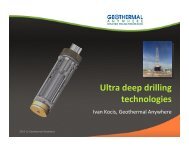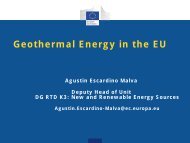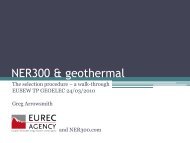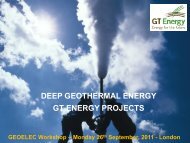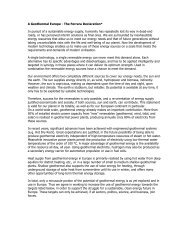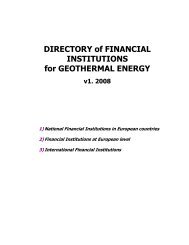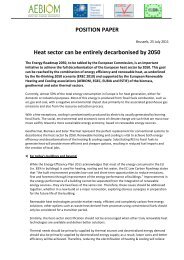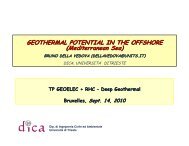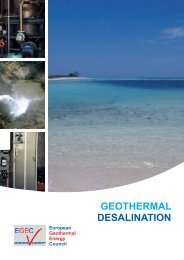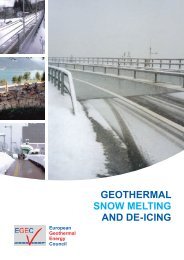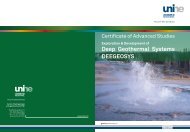Strategic Research and Innovation Agenda for Renewable ... - EGEC
Strategic Research and Innovation Agenda for Renewable ... - EGEC
Strategic Research and Innovation Agenda for Renewable ... - EGEC
Create successful ePaper yourself
Turn your PDF publications into a flip-book with our unique Google optimized e-Paper software.
5<strong>Strategic</strong> <strong>Research</strong> <strong>and</strong> <strong>Innovation</strong> <strong>Agenda</strong> <strong>for</strong> <strong>Renewable</strong> Heating & CoolingRHC applications to industrial processes<strong>Renewable</strong>Heating & CoolingEuropean Technology Plat<strong>for</strong>m5.1 Description of dem<strong>and</strong> characteristics1000Heat consumption <strong>for</strong> industrial processes represents a significant share of the totalDomestic (12 kWannual heat dem<strong>and</strong> in the EU 54 th ). The IEA estimates that in Europe in 2010 heat dem<strong>and</strong><strong>for</strong> industrial processes was 165 Mtoe 55 . The vast majority of this energy is produced by800Small commercial (100-200 kW th )the combustion of fossil fuels, with a huge impact in terms of greenhouse gas emissions.Capital costs biomass heat plants EUR/kWLarge commercial (350-1,500 kW th )Industrial heat dem<strong>and</strong> varies by temperature levels, sectors, countries, <strong>and</strong> energy600supply, since many different industrial processes appear <strong>and</strong> the Small energy industry supply (100-1,000 can kW th ) differfrom country to country due to local conditions. Three different temperature levels are usedhere <strong>for</strong> describing the quality of the dem<strong>and</strong> <strong>for</strong> heat to be used in Large various industry industries:(350-5,000 kW400th )• Low temperature level is defined as up to 95°C, corresponding to the typical heatdem<strong>and</strong>s <strong>for</strong> space heating. According to the study Ecoheatcool (2006), around 30% of totalindustrial heat dem<strong>and</strong> is required at temperatures below 100°C Low temperature heat200is needed <strong>for</strong> 2008 industrial 2010 2012 processes 2014 2016 like washing, 2018 2020rinsing, 2022 <strong>and</strong> food preparation. Some heatis also used <strong>for</strong> space heating <strong>and</strong> on-site hot water preparation.• Temperatures between 95ºC <strong>and</strong> 250ºC are defined “medium”. This heat is normally suppliedthrough steam. The purpose is often to evaporate or to dry. The Ecoheatcool studyshows that 27% industrial heat dem<strong>and</strong> is <strong>for</strong> temperatures between 100°C <strong>and</strong> 400°C,which includes the classifications “medium-” <strong>and</strong> “high-temperature” heat.• Temperatures 25 over 250ºC are “high” <strong>and</strong> needed <strong>for</strong> the manufacture of metals,ceramics, <strong>and</strong> glass etc. Temperatures above 400°C can be created by using hot flue gases,electric 20 induction, or other combustion processes.2010 202015Figure 30 provides a view of the distribution of industrial heat dem<strong>and</strong> by temperaturelevels in 10 Europe, as estimated by the IEA 56 . The graph also shows the expected trend of heatdem<strong>and</strong> until 2050, assuming efficiency gains could be realised in each of these realms 57 .5Figure 31 illustrates the breakdown of heat consumption by industry <strong>and</strong> by temperaturelevels as 0 identified by the Ecoheatcool. Different renewable energy technologies can8-166-124-94-94-9provide heat EUR/GJ at Low <strong>and</strong> EUR/GJ Medium temperature EUR/GJ EUR/GJ levels, as summarised EUR/GJ in Figure 32.In the short term, Domestic few renewable Small commercial energy Large commercial technologies, Small industry such as Large biogas, industry can provide heatat temperatures above 250 (100-200 ºC at costs kW) competitive (350 - 1,500 kW) with (100 fossil - 1,000 kW) fuel alternatives. (350 - 5,000kW) In future, hightemperature solar thermal collectors <strong>and</strong> deep geothermal technology may effectively supplythese needs. <strong>Strategic</strong> research priorities <strong>for</strong> high temperature renewable heat supply arethere<strong>for</strong>e presented in the following Sections of this Chapter.EUR cent/kWh%2520151050Temperature60%Mtoe100806040202010Mtoe20015010050High temperatureheat (>400˚C)Medium temperatureheat (100˚C - 400˚C)High temperatureheat (



